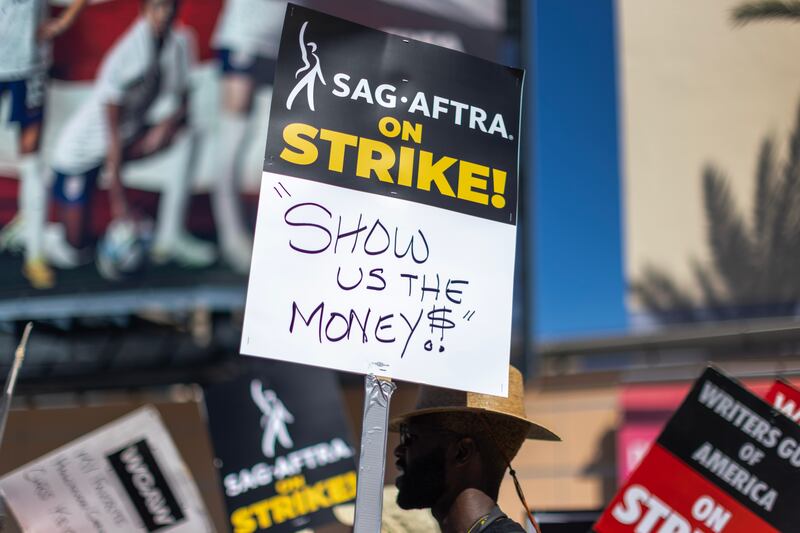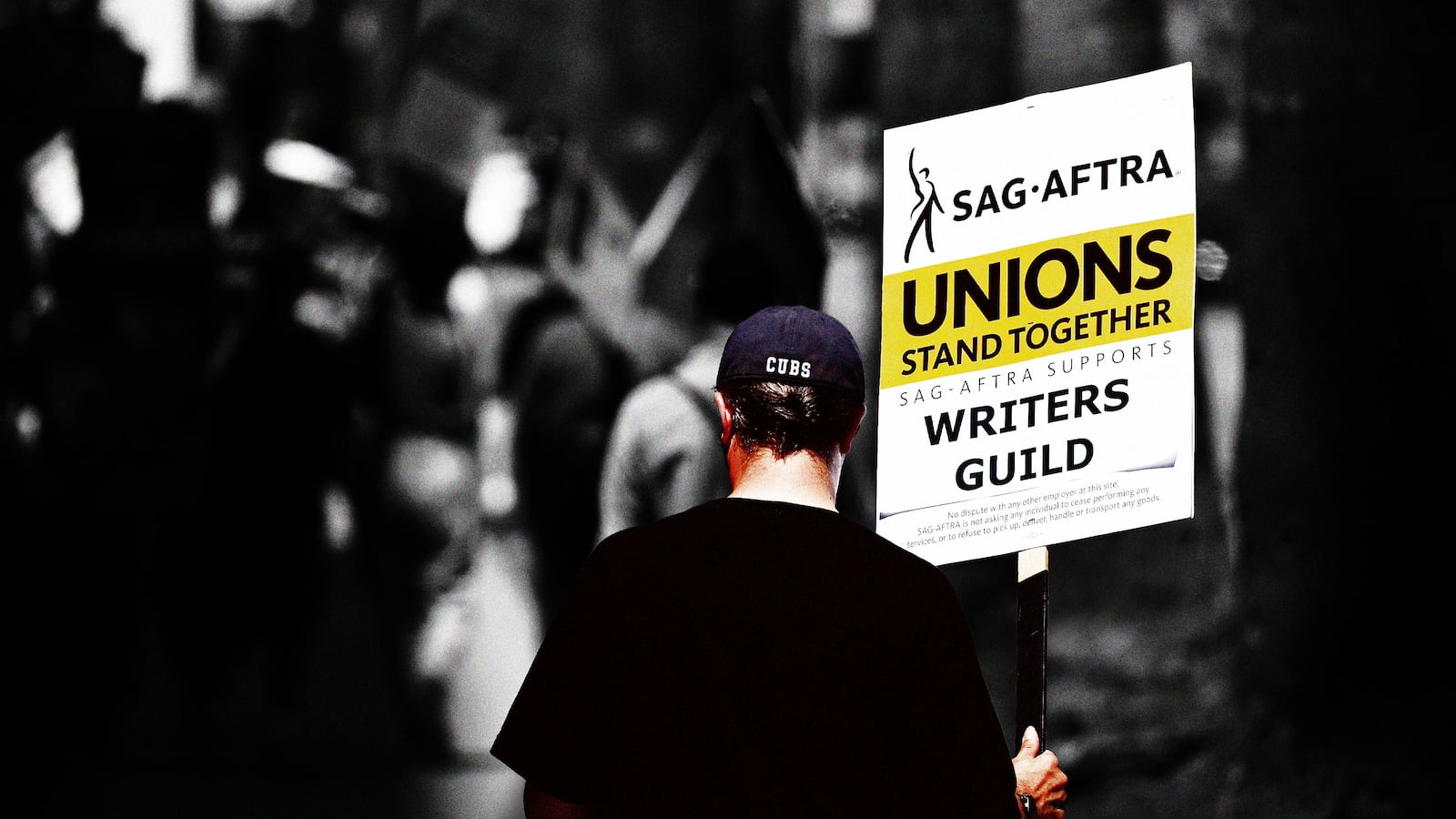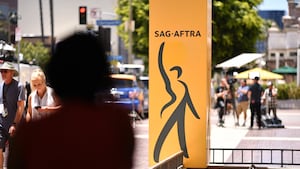HOLLYWOOD, California—Before the Screen Actors Guild and Writers Guild of America are even an hour into their Friday picket shift, the sidewalk in front of Paramount Studios’ lot is at capacity. It’s just 9:45 a.m. on the first day SAG is joining forces with the ongoing WGA strike, and already, the entire picket line space on Melrose Avenue in front of Paramount is overflowing with clever signs and booming voices demanding fair pay.
One of the WGA strike captains—whose job is usually to start chants and break the picket line for traffic to come through the studio’s front gates—redirects picketers to some of Paramount’s other gates. She shouts out the other entrances and points picketers down the street, “so that we are not overcrowded here and we are not giving Paramount any excuse to kick us out!”
Today marks day 75 of the WGA strike. The writers have been picketing studios like Netflix, Sony, and Warner Bros since May 1. Dozens of signs are stacked up against the walls of the Paramount lot, providing plenty of options for WGA picketers to rifle through as their rally call of the day. (“Student loan payment starts soon. Quit playin,” one reads. Another: “Keep writing a CAREER. Not a gig!”) Across Melrose, a SAG tent was erected to welcome the actors to the front lines.
SAG member and John Rosenfeld Studios acting teacher Jenna Johnson is upset that studios are unwilling to pay actors their due, but excited to see such a unified front: “Out here, it’s feeling really great,” Johnson says. “There are so many of us [actors] in Los Angeles. Having this unity feels really good, because at the end of the day, we all felt drawn to this because we love it.”
This is the first time both SAG and the WGA have protested together in over 60 years. Car horns blare up and down Melrose, honking in support of the strikers. The only thing louder than the cars is the protesters themselves, chanting, “LA is a union town!”
Early on Friday morning SAG president Fran Drescher stopped by Paramount’s neighbor, Netflix, with a message to protesters: “We are the victims here and they’re doing bad things to good people. They’re not willing to share in their wealth and change contracts to accommodate the new business model,” she said.

It’s a breezy day in Los Angeles—albeit incredibly sunny, and one protester offers me some shade with her sign—which makes it the perfect time to protest. No one is overheated—at least not yet. Even if it was 95 degrees, though, these folks wouldn’t be going anywhere. Stars including Patton Oswalt, Marg Helgenberger, and Gillian Jacobs were spotted marching alongside their union colleagues.
WGA member and Paramount lot coordinator Marcelina Chavira has been protesting for over two months, at this point. Next to her, a blow-up toy Orca holds a sign: “Fuck them yachts!” it reads, referencing studio CEOs who have plenty of boats and second homes. (Disney chief Bob Iger recently gave an interview calling union demands “not realistic,” while he is currently in the midst of building a new superyacht.) Chavira guides both WGA and SAG strikers into the picket line on Friday morning, ready to show new SAG folks the ropes.

“Since this is their first day, the [WGA] lot coordinators came early to coordinate with SAG and make sure that they’re alright,” Chavira says. “We’re really trying to empower them to do their own thing. We play together normally at work, so we’re playing together normally here. This is the hot labor summer. Everyone is standing up and fighting for a fair contract.”
WGA strikers have already perfected their signs: “FUCK YOU! PAY ME!” is scrawled in Sharpie on one marcher’s sign. “What CEO needs a $500 million salary?” another reads. “Remember that famous line that studio head wrote? ME NEITHER,” one reads, with the final part written in red to really make a point. SAG also joined in: “Greed is a deadly virus,” one SAG protester’s sign reads.

Chavira adds that, after the first few weeks of the WGA strike in May, things have since “chilled out” but that SAG joining is “a great new burst of energy coming in.”
Like the WGA, SAG is protesting for fair pay—more specifically, an increase in residuals for streaming content.
“Really what it comes down to is that you have all this art—TV, film—that got us through the pandemic,” Johnson says. “Now, these people can’t pay rent. They don’t get health insurance. They’re having to take on many supplemental jobs. And yet, you invite them into your homes on your TV every week.”
Meggan Anderson, who has been a SAG member since 2006, adds, “A lot of people, when they want to go home to Netflix and Chill, they don’t realize the thousands of people it takes for that to happen.”
“Most of us are living in our little studio apartments in the middle of the city, living from check to check,” she continues. “We’re not the 1 percent movie stars that people might think of at home.”

But even those big movie stars deserve to be treated fairly. Big summer stars like Barbie’s Margot Robbie and Oppenheimer’s Cillian Murphy, Emily Blunt, and Florence Pugh have already shown solidarity with the strike. Robbie told red carpet reporters, “I’m very much in support of unions and I’m a member of SAG, so I would support all that,” while the Oppenheimer stars walked out of the film’s London premiere when the strike was called. As a condition of the strike, SAG advised its members that they would not be able to promote their work through interviews, appearances, social media posts, or attending award shows.
“Thinking about the celebrity factor, because that feels like it’s been a thing—people are like, ‘What, are they trying to get richer?’” Johnson says. “But they’re [in Hollywood] for community consumption. Their lives are on display for us. We have to take care of people—emotionally, physically, financially—in order for them to be able to share themselves with the world.”

For those who aren’t big names, though, Anderson puts the pay in perspective: “Why is it that, if something plays on network TV, I can get a $20 residual,” she says, “but then, when it plays on a streaming network, I get 13 cents for the same amount of work?”
Another issue that’s been contentious in bargaining is the use of artificial intelligence to replace the work of actors. While the WGA has been trying to work against forces like ChatGPT that threaten to replace screenwriting jobs, SAG has been fighting studios on the same front. Just yesterday, it was reported that some studios had been looking into a feature that would scan background actors’ likenesses to recreate their bodies artificially in other scenes. These actors would only be paid for the initial scan, not for any future appearances.
“The problem is that a lot of people come to Los Angeles looking to follow their dreams and they don’t know better,” Johnson says. “They think, ‘Oh, this is what everybody does. This is what I have to do in order to make it.’ That’s not true. You are allowed to set boundaries and have control over what you want with your likeness and what kind of art you’re putting out there.”
Instead of signing away their likenesses, Johnson urges budding actors to join the strike.
“A lot of my students are non-union and they’re like, ‘How do we support?’” Johnson says. “I want people to come out and keep showing up. Build this community. Sometimes SAG can feel elitist—you’re either union or not. But people are working on getting into the union, and I want them to come and feel like they can have a voice.”
Plus, members of the WGA—who have already put over 10 weeks of effort into their strike—are ready to help guide new SAG protesters as they join the lines. Strike captain Molly Nussbaum says that a lot of SAG members were protesting alongside the WGA in solidarity before today. Now, those folks already know the drill.

“What’s been really amazing is that people have been like, ‘I can step up as a captain within SAG, I can help with SAG because I’ve been with the writers,’” Nussbaum says. “That solidarity that we’ve felt from the beginning—it’s amazing to see it on a different level.”
Having spent over two months leading the charge, Nussbaum does have some advice for SAG members joining the picket line today.
“Pace yourself! You don’t know how long you’re going to be out here,” she says. “Remember why you’re out here. Talk to your fellow members. Talk to people in the other unions. Share your experiences. Then, no matter how hot or tired or sweaty you get, you know that this is where you want to be.”
Nussbaum adds: “If our current situation is what we’ve got forever, would you be okay with that? The answer is a resounding no. If you keep asking yourself that question, it’s easy to show up.”








